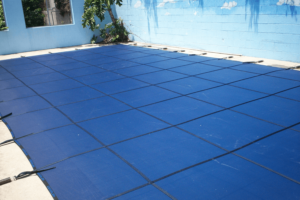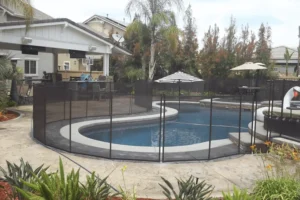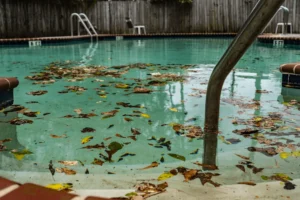Everyone loves a good pool party, but the great weather and cheer from the kids can lull you into a false sense of safety. You forget just how dangerous pools can be for kids if they aren’t supervised. According to the Centers for Disease Control, 800-900 children drown in swimming pools every year, with children aged 4 and under at the greatest risk.
But here’s the good news: You can do something to protect your loved ones. From what you teach your kids, to the types of pool safety barriers you install, there are the drowning prevention strategies you can use to keep your family and friends safer in your swimming pool.
Teach Your Children How to Swim
Some folks take to the pool like a duck to water, but not everyone is a natural swimmer. Swimming lessons are a great way to help kids as young as a year old (and adults) feel more comfortable in the water. Enrolling your kids in swimming lessons is the first line of defense in drowning prevention.
Enrolling them in lessons with a licensed teacher may be more important than you think. According to the USA Swimming Foundation, formal swimming lessons help reduce the likelihood of a child drowning by 88%. Lessons from a pro will make your pool time at home much safer.
Take a CPR Class
Not every kid gets the hang of swimming right away. So while the little ones are learning the backstroke, you should be learning another drowning prevention strategy: cardiopulmonary resuscitation (CPR). This technique is useful in many emergency situations, particularly when a person has stopped breathing (such as a near-drowning scenario). Knowing how to do CPR properly just might save a life.
The American Red Cross offers classes all over the country, and a simple web search should direct you to the nearest class. You can often learn CPR in a few short hours, gaining knowledge that will be invaluable in an emergency. Then you can enjoy your time in the pool with your family, knowing that if disaster does strike, you’ll be ready!
Appoint a Designated Lifeguard
Drowning is rarely like in movies, with splashing, thrashing, and shouting. In fact, people drowning are often silent. This is why supervision is an essential part of drowning prevention. No matter how many people are swimming in your pool, there should always be a “lifeguard” on duty. Start by learning the types of drowning to watch for.
If you’re throwing a pool party, it’s absolutely essential to have a supervisor watching the water. Consider asking the adults to take shifts (15 minutes each) being lifeguard. This gives everyone a chance to enjoy the pool, eat lunch, and chat with friends, while ensuring that someone is always keeping an eye on the swimmers and making sure they’re safe.
Block Pool Access
Unsupervised swimming doesn’t just happen at pool parties; in fact, many swimming injuries occur when no one else is near the pool area! The best way to keep people out of the water when they’re alone is to keep the pool covered. There are many great (and cost-effective) pool covers and pool nets available, so you can easily have one customized to fit both your pool and your budget.
This drowning prevention strategy may seem foolproof, but there are extra steps you should take to make it more effective. Keep water from collecting on top of your pool cover. If you have an above ground pool, remove all ladders and steps to it when not in use. Most importantly, communicate with your family and set firm boundaries regarding when they should and should not be by the pool.
Fence-In Your Pool
While a pool cover can be a great way to prevent kids from swimming alone, extra precautions should always be part of your drowning prevention strategy. A pool fence around the swimming area is important for any swimming pool.
Ideally, your pool fence should be at least 4 feet tall with vertical slats no more than 4 inches apart (the fence should not be completely solid, as that will block the view of the pool from the outside). Self-closing and self-latching gates (with latches outside a child’s reach) should be installed, ensuring that your little ones can’t get to the pool without your help and your supervision.
Install House Alarms
For some families, a pool fence or cover may just be one aspect of a drowning prevention strategy. If you want another tool to keep your family from pool-related accidents, alarms can be a great choice.
Install an alarm on the door of your home that leads to the pool area. This will alert you whenever someone goes out that door. This way, you’ll always be aware of who is approaching your pool, and you can take the appropriate steps to ensure everyone is safe at that moment.
Stay Sober
If you’re hosting a pool party, it’s pretty likely someone brought beer along. And while there’s no harm in having a drink while relaxing by the pool, having too many can seriously impair your ability to stay safe and keep others safe. It’s for this reason that Mayo Clinic suggests abstaining from alcohol anytime you go boating or swimming.
Staying sober is important for drowning prevention in many ways. When you are sober, you have an easier time keeping an eye on other swimmers, and you’ll be able to help others in the event of an injury. It also keeps you safer from drowning and other swimming injuries, as alcohol can slow your reflexes (or cause you to pass out).Keep Kids Away from Drains
The drain is an important part of any swimming pool. It keeps the water cycling through the skimmer. However, the powerful suction of the drain can spell trouble for little kids (particularly kids who aren’t strong swimmers). You can help prevent drowning by teaching children to stay away from the drain.
If a child sits too close to a pool drain, he or she can become trapped by the suction. Long hair, body parts, and baggy swimwear all present a risk, and if the child is not able to break away the result could be disastrous. To prevent this scary situation, teach kids who use your pool to stay away from anywhere they might become entangled.
Put Away the Pool Toys
Here is another drowning prevention strategy that only takes a few minutes of your time: put away all of your family’s pool toys.
Pool toys floating in the water are informal invitations for children to swim unsupervised. Also, if a pool toy falls into the water, there’s a chance that a child may try to retrieve it, and he or she falls into the pool in the process. Safely storing the pool toys is a good practice that can limit opportunities to fall into the water. But remember, this is not an adequate substitute for a pool fence, cover, or net.
Keep Emergency Gear Nearby
Make sure to have emergency equipment readily available in the pool area. This can include a shepherd’s hook, a life ring with a rope, or a reaching pole. You can even have all three. Make sure you know how to use these tools, as they can be life-saving drowning prevention methods. Even if you never use them, the peace of mind that comes from having these tools nearby is worth every penny.
Consult a Pool Safety Professional
All-Safe Pool Fence & Covers was founded for the purpose of saving lives, especially lives of young children. We hope you use these strategies to prevent drowning in and around your pool area. You can always call one of our pool safety professionals for a free on-site consultation and quote on the tools to help keep your family safe. Find your local professional here.



